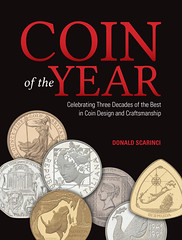
PREV ARTICLE
NEXT ARTICLE
FULL ISSUE
PREV FULL ISSUE
BOOK REVIEW: COIN OF THE YEAR’
Dick Johnson submitted this review of Don Scarinci's new book, Coin of the Year. Thanks!
-Editor
BOOK REVIEW: ‘COIN OF THE YEAR’ – FIRST BOOK OF ITS KIND
The book’s author, Donald Scarinci, wrote only a two-page introduction, “In Celebration of Achievement” and a paragraph on each top year’s winner. The photographs were taken by the author of coins from his own, nearly complete collection. “All but four “ the author tells me, “the four most difficult to obtain, the four palladium pieces.” He wanted it to be a picture book. The book is a first in its own right of delineating the beauty of a country’s most visible national image – its coins. How appropriate the first coin awarded that title in 1984, honored the first President of the United States, George Washington, in the first modern U.S. commemorative, the dollar coin of 1982, It was created by the first female Chief Engraver of the United States, Elizabeth Jones (with reverse by Matthew Peloso). The book is a testament to numismatic innovation. Sponsored by Krause Publications, the coins are selected for the Coin of The Year award from as many as several hundred nominations. The best ten are presented to the judges, all officials of Krause Publications, with one outside judge, the author, Donald Scarinci. The coins are judged for their beauty, significance, innovation and creativity. Design dominates the selection. Modern coinage technology, it seems, has advanced so far that every mint in the world, can produce perfectly struck specimens. It remains only for their design to make them distinctive. New coinage innovations have given rise to such coin features as: exotic edge lettering, ring blanks creating bi-metallic and tri-metallic coins, pad printing of color on a coin’s surface, inserts and inlays. not to overlook unusual shapes. All are present in the 280 winners dramatically shown in the book. While the coins are the visible winners, the mints, designers, engravers and modelers are the real winners. The award has inspired world mint officials to vie for the prize, giving greater attention to what can be attractive, significant and popular among their own population as well as collectors of the world. Perhaps that was the intention of Chet Krause and Cliff Mishler back in 1984 when they created and launched the program. Now for the categories. Fourteen categories have been awarded over the thirty years, new categories being created as conditions required, but never more than eleven in any one year. On five occasions tie awards were bestowed. In the first year two coins won in six categories. We suspect only two to start, they added four others later, perhaps when they chose six categories the second year, 1985. The first six were: Most Historically Significant, Most Artistic, Most Popular, Best Gold. Best Silver, Best Crown. Those six were awarded in virtually every year across the thirty-year span.. Best Trade Coin was added in 1987. Most Innovative in 1990 -- we can date the surge in modern coining technical innovations from this year. Most Inspirational was added in 1995. Best Contemporary Event was added a year later. Peoples Choice, added in 2008 allowed the public to have a say in the selection. Two recent categories were added last year, 2014, for Best Bi-metallic and Best Circulating Coin. An Index at the back of the book has a brief description of each winner. It follows the format from Krause’s World Coins publications: catalog number, denomination and composition listed for each country’s winners. It even lists the years that type was issued, quantity struck and prices in several conditions, And now for some notable winners. The best of each year is chosen from the winners in each category. So to choose One –the Best of the Best, the Grand Prix, the Best in Show, The Gold is chosen from the top winner in each of the thirty years. May I have the envelope please! And the winner is … The French Five Franc of 1991! It is the only coin which won in three categories in thirty years. They were: Most Artistic, Most Popular, Best Trade Coin. It featured the Eiffel Tower issued on its centennial, in an unusual perspective looking up the structure yet filling the circular boundary of the coin at the base. Other notable winners:
“I began collecting Krause Coin of the Year coins,” says author Scarinci, “shortly after I was appointed to the Citizens Coinage Advisory Committee in 2005.” This collection “focuses attention on new artists and on the world mints who strive to depict the past and the present in new and modern ways.” He has shown these coins to U.S. Mint officials in the past with the intent to encourage more modern and attractive coin designs for United States coins. Now he will have a bound document to present to fellow CCAC members and those reluctant Mint officials to influence their decisions for better coin designs of the future. Undoubtedly this book will be the center of attention at the next CCAC meeting. The book is the most beautiful Krause has published Every collector of world coins will find it of immense interest.
To read the earlier E-Sylum article, see:
The Numismatic Bibliomania Society is a non-profit organization promoting numismatic literature. See our web site at coinbooks.org. To submit items for publication in The E-Sylum, write to the Editor at this address: whomren@gmail.com To subscribe go to: https://my.binhost.com/lists/listinfo/esylum All Rights Reserved. NBS Home Page Contact the NBS webmaster 
|
